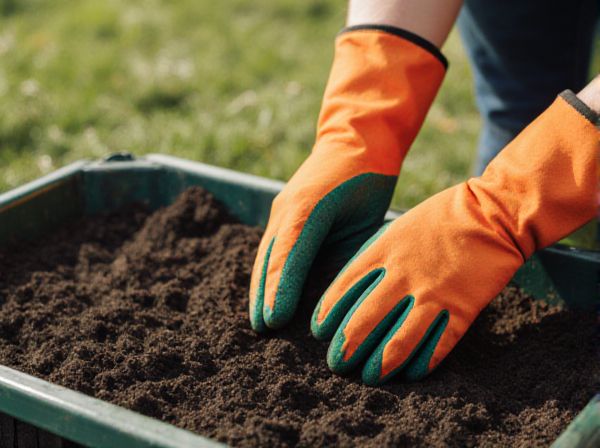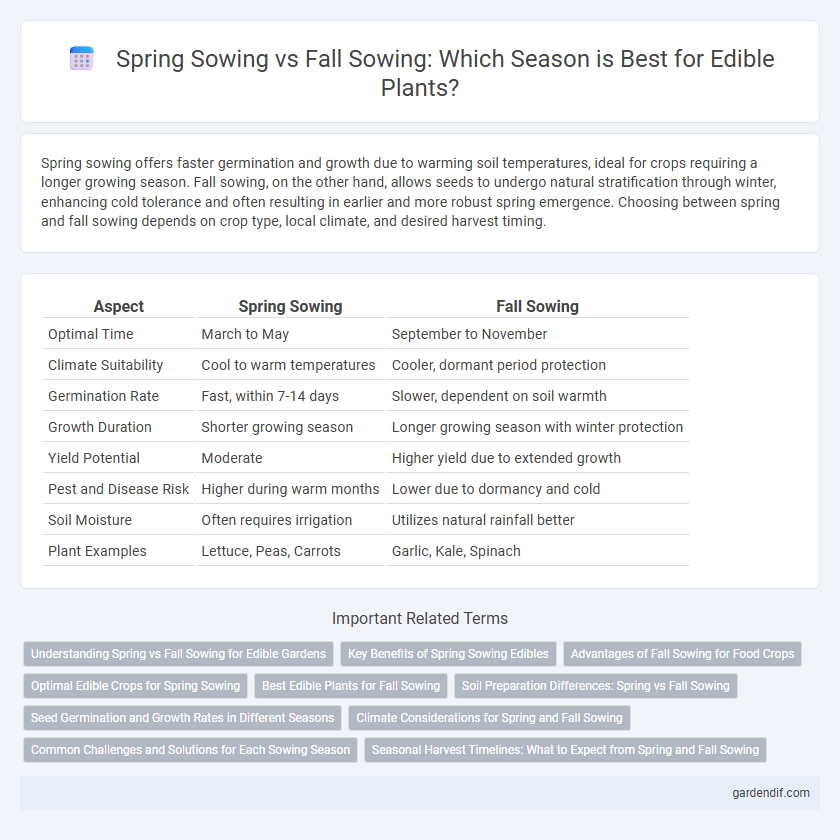
Spring sowing vs Fall sowing Illustration
Spring sowing offers faster germination and growth due to warming soil temperatures, ideal for crops requiring a longer growing season. Fall sowing, on the other hand, allows seeds to undergo natural stratification through winter, enhancing cold tolerance and often resulting in earlier and more robust spring emergence. Choosing between spring and fall sowing depends on crop type, local climate, and desired harvest timing.
Table of Comparison
| Aspect | Spring Sowing | Fall Sowing |
|---|---|---|
| Optimal Time | March to May | September to November |
| Climate Suitability | Cool to warm temperatures | Cooler, dormant period protection |
| Germination Rate | Fast, within 7-14 days | Slower, dependent on soil warmth |
| Growth Duration | Shorter growing season | Longer growing season with winter protection |
| Yield Potential | Moderate | Higher yield due to extended growth |
| Pest and Disease Risk | Higher during warm months | Lower due to dormancy and cold |
| Soil Moisture | Often requires irrigation | Utilizes natural rainfall better |
| Plant Examples | Lettuce, Peas, Carrots | Garlic, Kale, Spinach |
Understanding Spring vs Fall Sowing for Edible Gardens
Spring sowing allows seeds to germinate quickly as soil temperatures rise, promoting vibrant growth during the warm season, while fall sowing leverages cooler soil conditions to prepare hardy plants for early spring harvests. Understanding the specific requirements of edible crops, such as cool-season vegetables like spinach for fall sowing and warm-season crops like tomatoes for spring planting, optimizes yield and extends the growing season. Managing soil moisture and temperature through appropriate timing enhances seedling vigor and reduces risks of pests and diseases associated with improper sowing periods.
Key Benefits of Spring Sowing Edibles
Spring sowing of edibles accelerates plant growth by providing optimal temperatures and increasing daylight hours, resulting in faster germination and harvest times. This method reduces the risk of frost damage and allows for higher yields by taking advantage of the full growing season. Key benefits include improved seedling vigor, consistent moisture availability, and enhanced pest and disease management compared to fall sowing.
Advantages of Fall Sowing for Food Crops
Fall sowing offers significant advantages for food crops, including deeper root development due to cooler soil temperatures and increased moisture retention from autumn rains, leading to improved drought resilience. Crops sown in fall often benefit from natural cold stratification, enhancing seed germination rates and promoting earlier spring growth. This method reduces pest and disease pressure compared to spring sowing and allows for an extended growing season, resulting in higher yields and better crop quality.
Optimal Edible Crops for Spring Sowing
Optimal edible crops for spring sowing include peas, lettuce, radishes, and spinach, which thrive in cooler early-season temperatures and offer quick harvests. These crops benefit from well-drained soil with consistent moisture, enhancing germination and growth rates. Selecting varieties such as sugar snap peas and butterhead lettuce ensures robust yields and extended harvesting periods in spring gardens.
Best Edible Plants for Fall Sowing
Fall sowing favors hardy edible plants such as kale, spinach, garlic, and radishes that thrive in cooler temperatures and mature during early spring. These crops benefit from natural vernalization, leading to enhanced flavor and nutrient density. Choosing frost-tolerant varieties ensures successful germination and harvest in colder climates.
Soil Preparation Differences: Spring vs Fall Sowing
Spring sowing requires soil that is thoroughly thawed, warm, and well-drained to promote rapid seed germination and root establishment. Fall sowing benefits from soil that is worked and enriched with organic matter several weeks prior, allowing natural freeze-thaw cycles to improve soil structure and nutrient availability. Proper soil preparation timing directly influences seedling vigor and crop yield for both spring and fall planting schedules.
Seed Germination and Growth Rates in Different Seasons
Spring sowing generally promotes faster seed germination and vigorous growth due to warmer soil temperatures and increased daylight hours, optimizing photosynthesis and metabolic activities. In contrast, fall sowing exposes seeds to cooler temperatures that slow germination but allow plants to establish deep root systems, enhancing resilience during early growth stages. Seasonal differences in soil moisture and temperature significantly influence germination rates, with spring conditions accelerating seedling emergence and fall conditions supporting steady, long-term development.
Climate Considerations for Spring and Fall Sowing
Spring sowing aligns with rising temperatures and longer daylight hours, promoting seed germination and plant growth in temperate climates. Fall sowing leverages soil warmth and moisture retention, allowing roots to establish before winter dormancy in regions with mild winters. Climate considerations include frost risk in spring sowing areas and winter survival potential for crops sown in the fall.
Common Challenges and Solutions for Each Sowing Season
Spring sowing often faces unpredictable frost dates and soil moisture variability, requiring gardeners to select cold-tolerant seeds and employ row covers to protect seedlings. Fall sowing challenges include potential early frosts and soil dryness, prompting the use of mulch to retain moisture and timing seed planting to allow proper root establishment before winter. Both seasons benefit from soil testing and amendment to optimize nutrient availability and ensure robust plant growth.
Seasonal Harvest Timelines: What to Expect from Spring and Fall Sowing
Spring sowing typically results in a summer harvest, allowing crops like lettuce, peas, and radishes to mature quickly during warmer days. Fall sowing extends the harvest into late autumn or early winter, ideal for hardy vegetables such as kale, Brussels sprouts, and garlic that benefit from colder temperatures. Understanding these seasonal harvest timelines helps optimize yield and freshness, aligning planting schedules with crop-specific growth cycles.
Spring sowing vs Fall sowing Infographic

 gardendif.com
gardendif.com